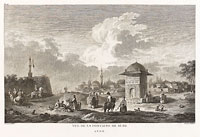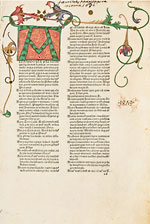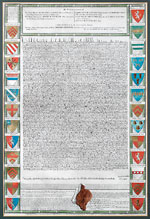Alphabet Soup
G is for Greece
Choiseul-Gouffier Variations, Bonhams ($10,045), Sotheby’s ($50,190), & Christie’s ($46,175), London
Twenty years later, some of the books on Greece and the Ottoman Empire that were once part of the magnificent library formed by the American collector, Henry M. Blackmer, returned for sale at Bonhams on March 31.
Given the present tough economic times and circumstances—this was a liquidation sale—prices did not always show the increase one might otherwise expect. However, other factors can greatly influence sale prices, as seen by differing prices paid for the Conte de Choiseul-Gouffier’s Voyage pittoresque de la Grèce of 1782–1822.
With a full complement of maps, plates, and plans, the ex-Blackmer first edition, in matching and period half red morocco gilt bindings, made £6,050 (then $10,045) in 1989. This time it went to a Greek buyer at £10,625 ($15,195).
A couple of exceptional copies have made more, among them one from the Atabey Library, which at Sotheby’s London in 2002 made £33,460, then $50,190. Because the work was issued over a period of 40 years, copies are usually found with at least the third and posthumously published volume bound later and differently, but in the Atabey set the 19th-century red morocco gilt bindings are at least a very close match and near contemporary.
But on the face of it, an even more starting result was the £25,095 (then $46,175) paid at Christie’s London in 2004 for a copy of the first volume only! This, however, was part of the Michael Wittock bindings collection, and what was really on offer was not a travel book, but a binding masterpiece in contemporary Parisian gold-tooled red morocco by Derome le jeune.
Illustrated here are Vue de la Fontaine de Scio, a plate from the ex-Blackmer copy sold at Bonhams in March; the handsomely bound Atabey set; and the Parisian gold tooled red morocco binding by Nicolas-Denis Derome, known as Derome le jeune, of the first volume from the Wittock collection.
L is for Latin
Early Latin Glossary, Bloomsbury Auctions, New York, $24,000.
A book from the much exhibited and admired library of Harry and Virginia Walton of Covington, Virginia, a 1477 edition of De priscorum proprietate verborum, by Junianus Maius, reflects the Waltons’ love of illuminated manuscripts and incunabula.
An important early glossary of Latin words and phrases, it was first published in Naples, ca. 1475, but this edition is one of only three works recorded from a small press set up in Treviso by Bernardus de Colonia, or Bernard of Cologne. His books are scarce, but the types he used are much admired, and he appears to have been a pioneer in the use of the typographical ligatures æ and œ.
The Walton copy of this scarce edition is decorated with 23 large illuminated initials, dated in gold 1479. The identity of the illuminator is not known, but an early ownership signature indicates that the book was in a Viennese institutional collection by 1686, and a laid-in page from an exhibition catalogue suggests that the illuminator may have been Austrian.
In a 17th-century binding of blind-stamped half calf over boards, it sold at $24,000 in the April 4 sale of the Waltons’ library.
M is for Magna Carta
The Printed Statutes, Bonhams, London, $14,585
The early-19th-century Whittaker printings are more frequently seen at auction, but the very first printing of the original text of Magna Carta was produced in 1733. Engraved and printed on vellum by John Pine, it was based on one of the two original copies then owned by Sir Robert Cotton and now in the British Museum. Possibly this facsimile was prompted by the fact that two years earlier, one of those Cottonian originals had been damaged by a fire at Ashburnam House.
As well as being a publisher and map- and printseller, Pine revelled in the titles of Bluemantle Pursuivant to the College of Arms and Engraver to the King’s Signet and Stamp Office, and in his version, the central panel of text is surrounded by 25 coats of arms of the barons, while at the foot is a representation of King John’s Great Seal. This very clean and well preserved copy sold for £10,200 ($14,585) to a collector at Bonhams on March 24.
All bar three of the statutes originally laid down in 1215 have since been repealed, but the key declaration that no man is above the law remains. “No man shall be seized or imprisoned, or stripped of his rights or possessions, or outlawed or exiled, Nor will we proceed with force against him, except by lawful judgment of his equals or by the law of the land, To no one will we sell, to no one deny or delay right or justice.”
In 2007, readers may recall, the only original manuscript copy still in private hands headed our Top 50 list. An issue dating from the reign of Edward I, dated 1297, it sold for $21.3 million.








 Ian McKay’s weekly column in Antiques Trade Gazette has been running for more than 30 years.
Ian McKay’s weekly column in Antiques Trade Gazette has been running for more than 30 years.

